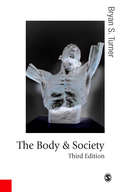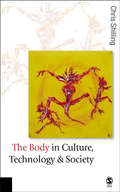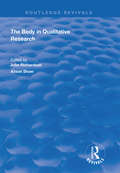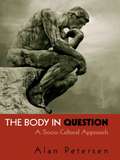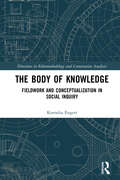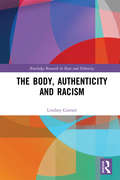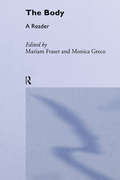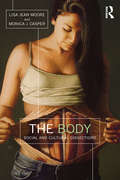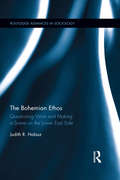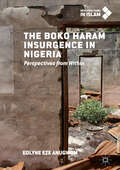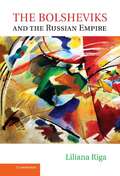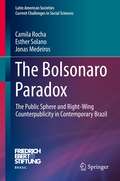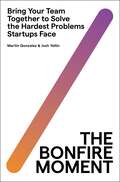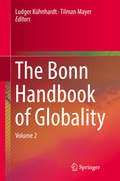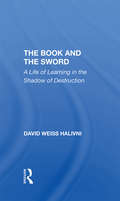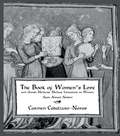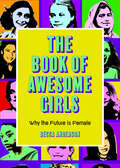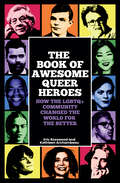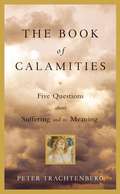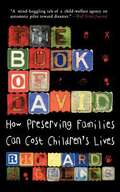- Table View
- List View
The Body and Society: Explorations in Social Theory (Published in association with Theory, Culture & Society #7)
by Bryan S. Turner"This truly deserves to be considered a classic and I strongly encourage my students to read it from cover to cover. Turner's work on the body needs to be considered in its own right within courses on the sociology of the body." - Dr Robert Meadows, Surrey University "Remains the foundational text for courses in the sociology of the body, replete with insights and a depth of analysis that has largely inspired an entire new area of studies across the social sciences." - Dr Michael Drake, Hull University "This is THE contemporary text for both academics and students exploring the sociology of the body." - Jessica Clark, University Campus Suffolk This is a fully revised edition of a book that may fairly claim to have re-opened the sociology of the body as a legitimate area of enquiry. Providing an unparalleled guide to all aspects of the subject, each chapter has been revised and updated while the book contains new material that reflects both recent changes in the field and Turner's developing position on the centrality of vulnerability. Assured and innovative, this book provides the most authoritative statement of work on the sociology of the body by one of the leading writers in the field.
The Body in Culture, Technology and Society (Published in association with Theory, Culture & Society)
by Chris Shilling`This is an impressive book by one of the leading social theorists working in the field of body studies. It provides a critical summation of theoretical and substantive work in the field to date, while also presenting a powerful argument for a corporeal realism in which the body is both generative of the emergent properties of social structure and a location of their effects. Its scope and originality make it a key point of reference for students and academics in body studies and in the social and cultural sciences more generally' - Ian Burkitt, Reader in Social Science, University of Bradford `Chris Shilling is as always a lucid guide through the dense thickets of the "sociology of the body", and his chapters on the fields of work, sport, eating, music and technology brilliantly show how abstract theoretical debates relate to the real world of people's lives' - Professor Stephen Mennell, University College Dublin `What we are offered here is... a step change in perspective on "body matters" that is both innovative and of fundamental importance to anyone working on this sociological terrain... This text is groundbreaking and simply has to be read' - Acta Sociologica This is a milestone in the sociology of the body. The book offers the most comprehensive overview of the field to date and an innovative framework for the analysis of embodiment. It is founded on a revised view of the relation of classical works to the body. It argues that the body should be read as a multi-dimensional medium for the constitution of society. Upon this foundation, the author constructs a series of analyses of the body and the economy, culture, sociality, work, sport, music, food and technology.
The Body in Late-Capitalist USA
by Donald M. LoweIn The Body in Late-Capitalist USA, Donald M. Lowe explores the varied social practices that code and construct the body. Arguing that our bodily lives are shaped by a complex of daily and ongoing practices--how we work, what we buy and consume--Lowe contends that as a result of the commodification of these and other social practices in the late-twentieth century, what we often understand to be the needs of the body are in fact means for capital accumulation. Moving beyond studies of representations and images of the body, Lowe focuses on the intersection of body practices, language, and the Social to describe concretely the reality of a lived body. His strongly synthetic work brings together Marxist critique, semiotics, Foucaultian discourse analysis, and systems and communications theory to examine those practices that construct the body under late capitalism: habits of work and consumption, the ways we give birth and raise children, socialization, mental and physical healing, reconstructions and contestations of sexuality and gender. Lowe draws upon a wide range of sources, including government and labor studies and statistics, diagnostic and statistical manuals on mental illness, computer manuals, self-help books, and guides to work-related stress disorders, to illustrate the transformation of the body into a nexus of exchange value in postmodern society.
The Body in Qualitative Research (Routledge Revivals)
by John Richardson Alison ShawFirst published in 1998, the three main themes of the book are representation (images and symbols which depict the body), regulation (the social control of bodies) and resistance (strategies which challenge dominant representation and regulation). These themes run through the various chapters which span a wide spectrum of bodily topics. The chapters deal not only with major issues such as media images of male and female bodies, but also with neglected problems such as workplace bullying, unusual settings such as residential institutions for trainee clergy and 'exotica' such as naturism and fetish practices. The topics range from the healthy and sporting - bodybuilding clubs and rugby culture - through to the health problems of Crohn’s Disease sufferers and the self-harm practices of women in bail hostels. Also, the book sheds light on the ageing process by including not just young people (teenage girls in physical education lessons) but also the older and increasingly assertive generation of 'wrinklies.'
The Body in Question: A Socio-Cultural Approach
by Alan PetersenWhy is there currently such strong academic and popular interest in ‘the body’ in contemporary societies? What factors shape our conceptions of the body, its naturalness, health and normality? What is the mind-body dualism and why should it matter? This book examines these and other body questions from a critical socio-cultural perspective. In particular, it shows how conceptions of the body are affected by processes of individualization, medicalization and commodification. Chapters discuss the impact of new biomedical technologies on the notion of the natural body, efforts to reshape and perfect the body, the role of the media in ‘framing’ body issues, processes of body classification, the impact of consumerism on concepts of health, healing and self-care, and the implications of theoretical and practical efforts to ‘integrate’ mind and body. This book will be an invaluable source for those seeking to understand the social, cultural and political significance of ‘the body’ in contemporary society.
The Body of Knowledge: Fieldwork and Conceptualization in Social Inquiry (Directions in Ethnomethodology and Conversation Analysis)
by Kornelia EngertThis book presents a vivid and close-up view of social science researchers engaged in fieldwork, in discussions with colleagues, and in writing. Adopting an ethnographic approach inspired by ethnomethodology and conversation analysis, the author pursues a praxeological analysis of social inquiry in situ. By conceiving of analytical practices such as observation, shop talk, and conceptualization in experiential terms, the seen but unnoticed structures of knowledge work are exposed and made available for empirical analysis. In a departure from ethnographic studies of research that focus on the physical sciences, the author uses the example of sociological research to shed new light on the role of self and mind for epistemic cultures, on the elusive materiality of conceptual objects, and on researchers’ experiential ways of seizing, reviewing, and accrediting knowledge. A rich and pervasive study of elementary sites in the research process, The Body of Knowledge will appeal to scholars of sociology, anthropology, and the humanities with interests in the epistemic practice of their own discipline, as well as those working in fields such as the social study of science, ethnomethodology and conversation analysis, and the sociology of interaction.
The Body, Authenticity and Racism (Routledge Research in Race and Ethnicity)
by Lindsey GarrattThe modern world may believe that authenticity empowers us to be our true selves. However, is this really true for all people? Would authenticity be accepted by others if it does not fit within the conceptions of those who embody "nationally authorised" attributes? Drawing upon an in-depth study of young children in Dublin’s North inner city, The Body, Authenticity and Racism offers detailed insight into how racism is created and perpetuated within 7–9-year-old boys’ interactions with one another. Indeed, through unique empirical data, this enlightening title demonstrates the importance of discussing the body when examining racism – not only in how the body is judged and racialised by other people, but how it is an apparent medium through which racism operates and disappears into. Garratt also explores how masculinity, belonging to a local area and being accepted as ‘Irish’ is intricately interwoven within gendered and racist assumptions; which comes not only from wider discourses but are actively constructed and reconstructed by children themselves. Using a Bourdieusian method of analysis and phenomenological philosophy, this book ultimately highlights the role of authenticity in hiding racism amongst children. A timely volume, it will appeal to undergraduate and postgraduate students, as well as postdoctoral researchers interested in fields such as Sociology, Ethnic and Racial Studies, Irish Studies and Masculinities Studies.
The Body: A Reader (Routledge Student Readers)
by Mariam FraserThe body has become an increasingly significant concept in recent years and this Reader offers a stimulating overview of the main topics, perspectives and theories surrounding the issue. This broad consideration of the body presents an engagement with a range of social concerns, from the processes of racialization to the vagaries of fashion and performance art, enacted as surgery on the body. Individual sections cover issues such as:the body and social (dis)orderbodies and identitiesbodily normsbodies in health and dis-easebodies and technologies.Containing an extensive critical introduction, contributions from key figures such as Butler, Sedgwick, Martin Scheper-Huges, Haraway and Gilroy, and a series of introductions summarizing each section, this Reader offers students a valuable practical guide and a thorough grounding in the fascinating topic of the body.
The Body: Social and Cultural Dissections (Biopolitics Ser.)
by Monica J. Casper Lisa Jean MooreThis college-level handbook offers a comprehensive and accessible overview of sociological and cultural perspectives on the human body. Organized along the lines of a standard anatomical textbook delineated by body parts and processes, this volume subverts the expected content in favor of providing tools for social and cultural analysis. Students will learn about the human body in its social, cultural, and political contexts, with emphasis on multiple, contested meanings of the body, body parts, and systems. Case studies, examples, and discussion questions are both US-based and international. Advancing critical body studies, the book explicitly discusses bodies in relation to race, class, gender, sexuality, ability, age, health, geography, and citizenship status. The framing is sociological rather than biomedical, attentive to cultural meanings, institutional practices, politics, and social problems. The authors use commonly understood anatomical frames to discuss social, cultural, political, and ethical issues concerning embodiment.
The Bohemian Ethos: Questioning Work and Making a Scene on the Lower East Side (Routledge Advances in Sociology #143)
by Judith R. HalaszThe iconoclastic ingenuity of bohemians, from Gerard de Nerval to Allen Ginsberg, continually captivates the popular imagination; the worlds of fashion, advertising, and even real estate all capitalize on the alternative appeal of bohemian style. Persistently overlooked, however, is bohemians' distinctive relationship to work. In this book, sociologist Judith R. Halasz examines the fascinating junctures between bohemian labor and life. Weaving together historiography, ethnography, and personal experiences of having been raised amidst downtown New York's bohemian communities, Halasz deciphers bohemians' unconventional behaviors and attitudes towards employment and the broader work world. From the nineteenth-century harbingers on Paris' Left Bank to the Beats, Underground, and more recent bohemian outcroppings on New York's Lower East Side, The Bohemian Ethos traces the embodiment of a politically charged yet increasingly precarious form of cultural resistance to hegemonic social and economic imperatives.
The Bohemian South: Creating Countercultures, from Poe to Punk
by Edited By Shawn Chandler Bingham and Lindsey A. FreemanFrom the southern influence on nineteenth-century New York to the musical legacy of late-twentieth-century Athens, Georgia, to the cutting-edge cuisines of twenty-first-century Asheville, North Carolina, the bohemian South has long contested traditional views of the region. Yet, even as the fruits of this creative South have famously been celebrated, exported, and expropriated, the region long was labeled a cultural backwater. This timely and illuminating collection uses bohemia as a novel lens for reconsidering more traditional views of the South. Exploring wide-ranging locales, such as Athens, Austin, Black Mountain College, Knoxville, Memphis, New Orleans, and North Carolina's Research Triangle, each essay challenges popular interpretations of the South, while highlighting important bohemian sub- and countercultures. The Bohemian South provides an important perspective in the New South as an epicenter for progress, innovation, and experimentation.Contributors include Scott Barretta, Shawn Chandler Bingham, Jaime Cantrell, Jon Horne Carter, Alex Sayf Cummings, Lindsey A. Freeman, Grace E. Hale, Joanna Levin, Joshua Long, Daniel S. Margolies, Chris Offutt, Zandria F. Robinson, Allen Shelton, Daniel Cross Turner, Zackary Vernon, and Edward Whitley.
The Boko Haram Insurgence In Nigeria: Perspectives from Within (New Directions in Islam)
by Edlyne Eze AnugwomThis book focuses on the Boko Haram insurgence in Nigeria, and provides information on the origin and growth of the sect, antecedent and historical factors behind the insurgence, assessing a variety of socio-political drivers. The structure, organization and ideology of the sect are analysed, paying attention to internal splits within the group, as well as external relations with the Nigerian state, and global jihadism. The diverse and wide ranging issues covered in the book makes it valuable for academic researchers, students and policy practitioners both within Africa and beyond.
The Bolsheviks and the Russian Empire
by Liliana RigaThis comparative historical sociology of the Bolshevik revolutionaries offers a reinterpretation of political radicalization in the last years of the Russian Empire. Finding that two-thirds of the Bolshevik leadership were ethnic minorities - Ukrainians, Latvians, Georgians, Jews and others - this book examines the shared experiences of assimilation and socioethnic exclusion that underlay their class universalism. It suggests that imperial policies toward the Empire's diversity radicalized class and ethnicity as intersectional experiences, creating an assimilated but excluded elite: lower-class Russians and middle-class minorities universalized particular exclusions as they disproportionately sustained the economic and political burdens of maintaining the multiethnic Russian Empire. The Bolsheviks' social identities and routes to revolutionary radicalism show especially how a class-universalist politics was appealing to those seeking secularism in response to religious tensions, a universalist politics where ethnic and geopolitical insecurities were exclusionary, and a tolerant 'imperial' imaginary where Russification and illiberal repressions were most keenly felt.
The Bolsonaro Paradox: The Public Sphere and Right-Wing Counterpublicity in Contemporary Brazil (Latin American Societies)
by Camila Rocha Esther Solano Jonas MedeirosThis book presents the first in-depth academic investigation published in English about one of the most radical incarnations of the current global wave of new right-wing movements and governments: the movement that brought to power the current Brazilian president, Jair Bolsonaro. The rise of this new right-wing movement in Brazil came as a surprise to many analysts who used to see the country as a successful example of the implementation of progressive social policies in the first decade of the 21st century, and posed many questions to those seeking to understand the role Brazil now plays in the development of this international far-right wave. The authors of this volume try to answer some of these questions by presenting the results of an extensive field research conducted over the years with Bolsonaro supporters and members of the new Brazilian right-wing movements. They have analyzed quantitative and especially qualitative data to accompany the accelerated transformations of the Brazilian public sphere, starting from small liberal and conservative groups on social media towards larger audiences via book publishing, the education system, the mainstream media, and the political-party system. By framing the Brazilian case in the wider international political scenario, The Bolsonaro Paradox: The Public Sphere and Right-Wing Counterpublicity in Contemporary Brazil will be an invaluable resource for sociologists, political scientists, international relations scholars and other social scientists – as well as to journalists and political analysts – interested in better understanding the role Brazil plays in the global rise of new far-right movements and governments.
The Bonfire Moment: Bring Your Team Together to Solve the Hardest Problems Startups Face
by Martin Gonzalez Joshua YellinAN INTERNATIONAL BESTSELLERUnique insights from pioneers of Google’s Startup Accelerator on why building teams is harder than building tech—and a proven way to develop a strong, resilient and effective team.Most startups fail not because of a bad product, poor timing, or mismanaged cash, but because of people problems: conflicts over strategy, decision-making, and team culture. Even the smartest entrepreneurs have been derailed by these soft problems: How do you fire a loyal friend who’s not up to par? How do you motivate your team to give their all? What happens when egos and emotions overpower facts and reason? The soft stuff can be shockingly hard.Martin Gonzalez and Josh Yellin outline the common traps startup teams fall into, and share their powerful one-day workshop that helps teams escape those traps. The unique process of The Bonfire Moment brings colleagues together for a full day of facing hard truths, noticing hidden dynamics, and gearing up for the intense challenges of startup life. When the constant hustle feels overwhelming, a team’s Bonfire Moment pulls them out of the day-to-day intensity to reflect and reboot.The Bonfire Moment has proven effective with hundreds of teams of all sizes around the world—from the smallest startups to large organizations—significantly improving their cohesion, focus and effectiveness. Now this book will teach leaders the principles behind The Bonfire Moment and how to run the workshop on their own. It's ideal for anyone who needs to build an extraordinary team to achieve big goals.
The Bonn Handbook of Globality: Volume 2
by Ludger Kühnhardt Tilman MayerThis two-volume handbook provides readers with a comprehensive interpretation of globality through the multifaceted prism of the humanities and social sciences. Key concepts and symbolizations rooted in and shaped by European academic traditions are discussed and reinterpreted under the conditions of the global turn. Highlighting consistent anthropological features and socio-cultural realities, the handbook gathers coherently structured articles written by 110 professors in the humanities and social sciences at Bonn University, Germany, who initiate a global dialogue on meaningful and sustainable notions of human life in the age of globality.Volume 1 introduces readers to various interpretations of globality, and discusses notions of human development, communication and aesthetics.Volume 2 covers notions of technical meaning, of political and moral order, and reflections on the shaping of globality.
The Book And The Sword: A Life Of Learning In The Shadow Of Destruction
by David Weiss HalivniDavid Weiss Halivni emerges his original approach to critical study of the Talmudic text not only in its modern printed form but as it was in its original form, the Oral Torah from the mouths of countless sages.
The Book Of Women's Love
by NavasFirst published in 2005. Routledge is an imprint of Taylor & Francis, an informa company.
The Book of Awesome Girls: Why the Future is Female
by Becca AndersonCelebrate the Power of Girls in This Book for Teens"As Beyonce rightly declared, girls DO run the world." ?Vicki León, author of Uppity Women of Medieval Times#1 New Release Teen & Young Adult Women’s Biographies, Social Activists, and SociologyYou’re a teenage girl and this is the time you’re coming into your own. Girl empowerment is more accessible than you think. In The Book of Awesome Girls celebrate the power of girls and the famous girls who have shaped, and continue to shape, our future.An uncensored history of girl power. Before they were seasoned women, little feminists were changing society and inspiring future generations. At seventeen, Malala Yousafzai was awarded the Nobel Peace Prize. Days after her thirteenth birthday, Anne Frank began writing one of the most poignant glimpses of Nazi occupation. Packed with mini biographies of big she-ros, The Book of Awesome Girls features famous girls alongside the equally awesome teens omitted from the history books. With a bonus chapter on girl empowerment today, readers are invited to learn about modern figures like Greta Thunberg and Mari Copeny.Girls just wanna have nonfiction. Driven by girl empowerment, this collection of biographies tells the unique stories of strong voices —despite age. From artists to athletes, The Book of Awesome Girls showcases a plethora of passions and skill sets to prove that strong is the new pretty. According to these famous girls, you don’t have to be of voting age to make a difference.Inside, you’ll find captivating chapters such as:Little Entrepreneurs: Girls With Vision Beautiful Royals: Girls Who Rule the WorldDancers and Actresses: Turning Creativity into Social ChangeAnd more!If you’re looking for books for teen girls —or enjoyed young adult books like Teen Trailblazers, Herstory, Goodnight Stories for Rebel Girls, or 100 Extraordinary Stories for Courageous Girls — then you’ll love The Book of Awesome Girls.
The Book of Awesome Queer Heroes: How the LGBTQ+ Community Changed the World for the Better
by Eric Rosswood Kathleen ArchambeauSelf-Acceptance and Identity Affirmations for LGBT+ Teens (Ages 12-18) #1 New Release in Teen & Young Adult LGBTQ+ Issues, LGBTQ+ Issues, Maturing, and Civil and Human Rights A positive affirmations book with invaluable information for all queer teens Inspirational and motivational quotes and information. Queer Cheer provides advice and words of wisdom encouraging teens to find—and keep—their inner rainbow. Covering topics relevant to lgbt+ teens today, this instructional book includes everything ranging from bullies and discrimination to acceptance and advocating change. Illustrated words of encouragement from a friend. Authors Eric Rosswood and Jodie Anders know what it’s like to be a teen struggling with identity and societal norms. That’s why they’re fighting to counter the negativity facing queer teens now and in the future. Queer Cheer includes many teen voices offering tips, advice, related firsthand experiences, and other valuable knowledge. Inside Queer Cheer, find: Affirmations and words of wisdom focusing on areas specific to LGBT+ teens Thought-provoking questions that lead to self-acceptance and encourage positive change Illustrations and doodles that inspire, empower, and strengthen the hearts and minds of queer teens Readers of LGBTQIA+ books for young adults such as This Book Is Gay, All Boys Aren’t Blue, or The ABC’s of LGBT+ will love Queer Cheer. Also don’t miss this multi-award-winning author’s other books including Journey to Parenthood, We Make It Better, and The Ultimate Guide for Gay Dads.
The Book of Calamities: Five Questions About Suffering and Its Meaning
by Peter TrachtenbergWhat does it mean to suffer? What enables some people to emerge from tragedy while others are spiritually crushed by it? Why do so many Americans think of suffering as something that happens to other people-who usually deserve it? These are some of the questions at the heart of this powerful book. Combining reportage, personal narrative, and moral philosophy, Peter Trachtenberg tells the stories of grass-roots genocide tribunals in Rwanda and tsunami survivors in Sri Lanka, an innocent man on death row, and a family bereaved on 9/11. He examines texts from the Book of Job to the Bodhicharyavatara and the writings of Simone Weil. THE BOOK OF CALAMITIES is a provocative and sweeping look at one of the biggest paradoxes of the human condition--and the surprising strength and resilience of those who are forced to confront it.
The Book of Chatbots: From ELIZA to ChatGPT
by Robert CieslaPrimitive software chatbots emerged in the 1960s, evolving swiftly through the decades and becoming able to provide engaging human-to-computer interactions sometime in the 1990s. Today, conversational technology is ubiquitous in many homes. Paired with web-searching abilities and neural networking, modern chatbots are capable of many tasks and are a major driving force behind machine learning and the quest for strong artificial intelligence, also known as artificial general intelligence (AGI).Sophisticated artificial intelligence is changing the online world as advanced software chatbots can provide customer service, research duties, and assist in healthcare. Modern chatbots have indeed numerous applications — including those of a malicious nature. They can write our essays, conduct autonomous scams, and potentially influence politics.The Book of Chatbots is both a retrospective and a review of current artificial intelligence-driven conversational solutions. It explores their appeal to businesses and individuals as well as their greater social aspects, including the impact on academia. The book explains all relevant concepts for readers with no previous knowledge in these topics. Unearthing the secrets of virtual assistants such as the (in)famous ChatGPT and many other exciting technologies, The Book of Chatbots is meant for anyone interested in the topic, laypeople and IT-enthusiasts alike.
The Book of David: How Preserving Families Can Cost Children's Lives
by Richard J. GellesThis author critically examines family preservation programs and argues that they do not work and argues that society's first priority must be protecting children rather than preserving families.
The Book of Hygge
by Louisa Thomsen BritsThe most beautiful guide to the Danish custom of hygge, the everyday life philosophy for better living. Hygge is a feeling of belonging and warmth, a moment of comfort and contentment. This beautiful little book will help you to find hygge and embrace it every day. Make a pot of coffee, relax in your favourite chair and discover for yourself how life is better with hygge. 'Best [book] for the philosophy of hygge' You Magazine '. . . a philosophy for mindful living' The Guardian 'Her book is a thing of beauty' Irish Examiner
